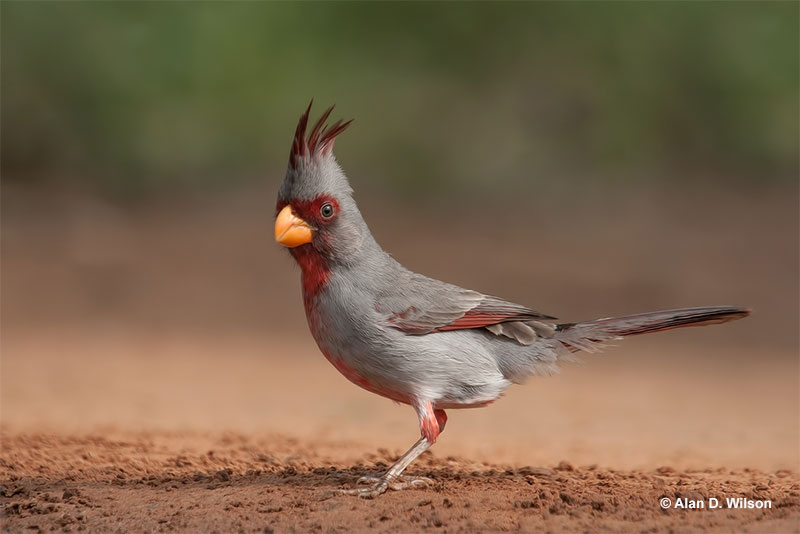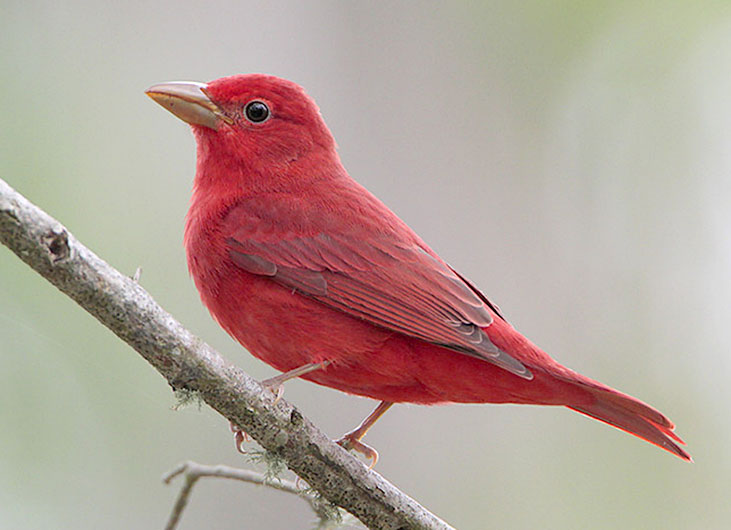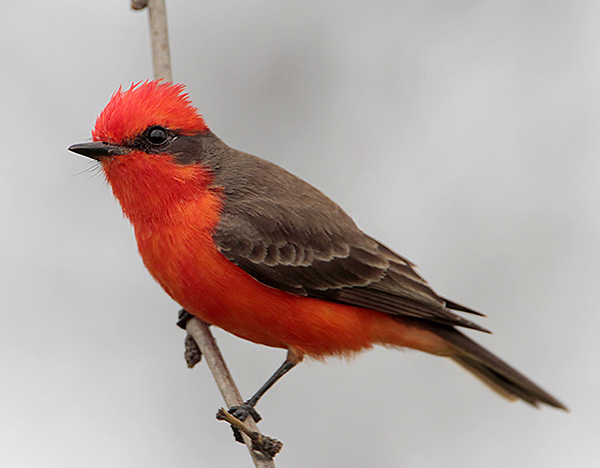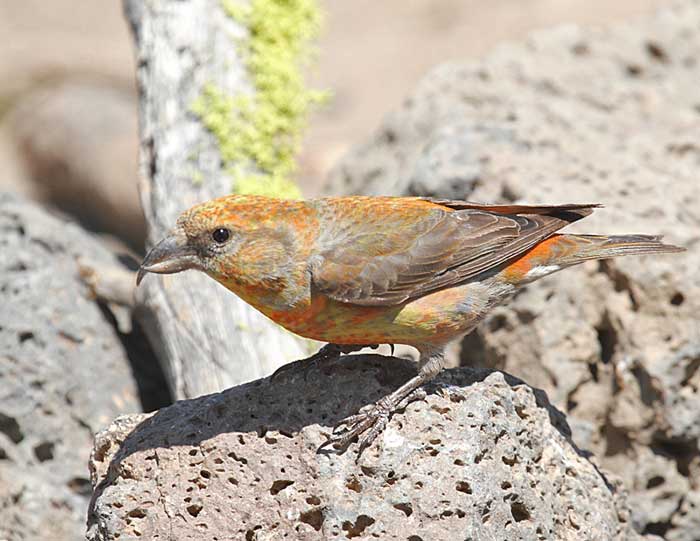
Cardinals are fantastic backyard birds. No matter how often I see cardinals, I’m always impressed by their bright colors and cheerful whistled songs!
With their brilliant red plumage, cardinals are also one of the easiest backyard birds to identify. Even so, some other bird species can look a bit like cardinals.
What are those bird species? Where do they live, and how can we recognize them?
What Do Cardinals Look Like?
Cardinals are easy birds to recognize, but it’s still good to know their main field marks. Males are entirely red with some black on their face and throat. Look closely, and we can also see that they have dusky red on their wings and tails and a touch of gray on their back.
The Northern Cardinal’s other main feature is its prominent crest and the bird’s orange-red, thick, conical beak. Females are different but still pretty easy to recognize. Instead of being entirely red, they are plumaged in soft grays and light browns with red on their wings, tail, and crest.

Female cardinals also have an orange-red beak and a bit of black on their face and throat. These pretty birds are 8.75 inches long (a bit smaller than an American Robin), and have short, rounded wings.
When I see Northern Cardinals fluttering between bushes, something else I always note is their longish, rounded tail.
There’s not much that looks like a Northern Cardinal, but the following birds share some characteristics.
Pyrrhuloxia

The Pyrrhuloxia is the one other bird in North America that looks most like a Northern Cardinal. Like its bright red cousin, Pyrrhuloxias also have a crest, a stout, conical beak, and red in their plumage.
They are also the same size and have the same shape with short, rounded wings, and a longish tail with a rounded tip. Female Pyrrhuloxias in particular look a lot like their female Northern Cardinal counterpart.
Both birds are dull brown and gray and have red in their crest, wings and tail. However, female Pyrrhuloxias don’t have any black on their face, and have a yellowish beak.
Like Northern Cardinals, Pyrrhuloxias forage on and near the ground for seeds and insects and can visit feeders too. However, they only live in arid habitats, often in places with lots of Mesquite plants. For this reason, they are also known as “Desert Cardinals.”
Summer Tanager

If you see a Summer Tanager and are reminded of a Northern Cardinal, you’ve got a good excuse. Despite the bird’s name, Summer Tanagers are in the same family as the Northern Cardinal.
They are a little bit smaller but can also show a slight crest. Male Summer Tanagers are entirely rose red, but other than that red coloration; they don’t resemble Northern Cardinals in other ways.
Instead of having a conical red beak, Summer Tanagers have a thick, grayish bill. They also lack black on their face, and their tail isn’t as long or rounded. One thing I also like to note on Summer Tanagers is their longish wings.
Those long wings are suited for flying long distances and remind me of the migrations they undertake twice per year. You won’t see Summer Tanagers in winter, at least not unless you go birding in Mexico or Central America.
Vermilion Flycatcher

Based on its striking red plumage, the male Vermilion Flycatcher might remind you of a Northern Cardinal. However, it differs from the familiar backyard bird in lots of other ways.
Vermilion Flycatchers are in a completely different family, have slender beaks, and sally to snatch small insects in flight. Males also have black upperparts, a thick black line going back from their eyes, and a bit of white edging on their black wings and tail.
You don’t have to worry about confusing female or young Vermilion Flycatchers with a Northern Cardinal. They don’t look anything like them! These birds are mostly grayish above, have grayish streaks on a white chest, and either yellow or pinkish belly and undertail.
I have seen both species in the same places, but Northern Cardinals forage on or near the ground, and Vermilion Flycatchers perch on a prominent branch, often near water.
Scarlet Tanager

The Scarlet Tanager is related to the Northern Cardinal and both species often live near each other. However, Scarlet Tanagers are a bit smaller and they look pretty different.
Male Scarlet Tanagers might also have bright red plumage but they don’t have a crest. Their grayish beak might also be thick but it doesn’t have a conical shape. Most of all, males in breeding plumage have velvet black wings and tail.
By fall, they lose their red plumage and don’t look like cardinals at all. At that time of year, Scarlet Tanagers are yellow-olive with dark wings and a dark tail.
They also act differently. More than once, I’ve watched a Northern Cardinal sing from the top of a bush while hearing a Scarlet Tanager singing from a nearby forest. Cardinals will also come to feeders, but Scarlet Tanagers stick to eating bugs and berries high in trees.
Red Crossbill

Male Red Crossbills also have red plumage but it’s duller than a Northern Cardinal.
They also lack the cardinal’s contrasting black face patch, have long dark wings, and a short, forked tail. Most of all, Red Crossbills have uniquely shaped beaks. Instead of a red conical bill, like other crossbill species, Red Crossbills have a beak with a “crossed tip.”
You won’t confuse female and young Red Crossbills with a Northern Cardinal. They are orange or olive with dark wings and tail! This interesting finch species also acts quite differently.
Instead of visiting feeders and feeding in low vegetation, flocks of Red Crossbills wander in search of coniferous trees. They use their unique beaks to pry open the cones of pines, firs, and evergreens and eat their seeds.
Phainopepla

The Phainopepla is a unique bird that lives in deserts and arid habitats from California to Mexico. Since it has a crest, is sort of shaped like a slender Northern Cardinal, and has dark plumage, some folks jokingly refer to Phainopeplas as “Goth Cardinals”!
It is true that these dark birds don’t have any bright-colored or cheery highlights. Males have glossy black feathers, reddish eyes, and a short beak, while female Phainopeplas are dark gray with some white edging on their wings. With their long, rounded tail and short, rounded wings, these desert birds might remind you of a cardinal in flight.
However, you won’t find these neat desert wanderers at feeders. Phainopeplas have the distinction of being “mistletoe specialists”. No, it doesn’t mean that they try to kiss other birds that happen to be perched under mistletoe plants.
They frequent mistletoe to feast on this parasitic plant’s berries.
Cedar Waxwing

Summer birding means Northern Cardinals sweetly singing in backyard vegetation. As the cardinals whistle their cheery, sweet summer songs, another crested bird whispers from the treetops.
Cedar Waxwings remark on the hot, lazy summer weather with high-pitched, easy-going calls. Now and then, one flies out to catch a bug, but they also gorge themselves on treetop berries. Spot one and their crest and black facial markings might remind you of a Northern Cardinal.
Their soft brown coloration is also reminiscent of female Northern Cardinals, but the similarities stop there. To find any red coloration, you’ll have to take a close look at their long wings and look for a few tiny red dots.
Two other field marks I often notice on Cedar Waxwings are the bright yellow tail tip and yellow belly. Cardinals don’t have those!
Tufted Titmice

While watching backyard feeders, some folks wonder if they are seeing small gray cardinals. Those neat little birds are titmice, and if you live in eastern North America, that “mini cardinal” is a Tufted Titmouse.
These small birds can remind us cardinals but are actually related to chickadees. Like the Northern Cardinal, the Tufted Titmouse has a perky crest, and it has a roughly similar shape. It also eats some of the same seeds as the Northern Cardinal but has a soft spot for peanuts.
Unlike Northern Cardinals, Tufted Titmice are blue-gray above and white below with peach flanks. Even if they don’t have any of the cardinal’s red feathers, they are still handsome little birds!
Another way to separate them is by looking at the bird’s face, beak, and size. Tufted Titmice are only a bit bigger than a sparrow, have a white face, and a dark, stubby bill.
Frequently Asked Questions
What bird looks like a gray cardinal?
The bird that looks like a gray cardinal could be a Pyrrhuloxia, titmouse species, or female Phainopepla. These three species all have gray plumage and crests that remind us of cardinals.
What bird looks like a cardinal but is blue?
The bird that looks like a cardinal but is blue might be a Blue Jay, Steller’s Jay, Blue Grosbeak, or Tufted Titmouse. Each of these species has varying amounts of blue or blue-gray plumage, and a crest reminiscent of a cardinal.
What birds look the most similar to cardinals?
The birds that look most similar to cardinals are Pyrrhuloxias. This species is closely related to the Northern Cardinal but has a yellowish beak and a lot more gray in its plumage.

